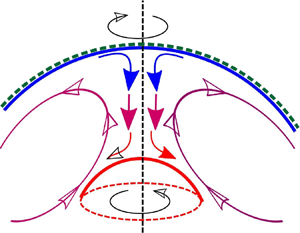Article contents
Bistability and hysteresis of axisymmetric thermal convection between differentially rotating spheres
Published online by Cambridge University Press: 25 January 2021
Abstract

Heating a quiescent fluid from below gives rise to cellular convective motion as the temperature gradient becomes sufficiently steep. Typically, this transition increases heat transfer. Differentially rotating spherical shells also generate a state of cellular motion, which in this case transports angular momentum. When both effects are present, it is often assumed that the fluid adopts a configuration which maximises the transfer of angular momentum and heat. Depending on how the equilibrium is reached, however, this maximisation may not always be achieved, with two different stable equilibria often co-existing for the same heating and rotation strengths. We want to understand why the fluid motion in a spherical shell is bistable, and how this scenario might arise. We consider a deep, highly viscous fluid layer, of relevance to the ice shells of Saturn's and Jupiter's moons. We find that bistability depends largely on the relative strength of heating and differential rotation, as characterised by the Rayleigh number  $Ra$ and inner sphere Reynolds number
$Ra$ and inner sphere Reynolds number  $Re_1$, and that the nature of the transition between bistable states depends strongly on the ratio of momentum diffusivity
$Re_1$, and that the nature of the transition between bistable states depends strongly on the ratio of momentum diffusivity  $\nu$ to thermal diffusivity
$\nu$ to thermal diffusivity  $\kappa$ defined by the Prandtl number
$\kappa$ defined by the Prandtl number  ${\textit {Pr}} = \nu /\kappa$. In particular, we find that the transition between solutions at large
${\textit {Pr}} = \nu /\kappa$. In particular, we find that the transition between solutions at large  ${\textit {Pr}}$, depends on the strength of thin thermal layers and can occur either due to the destabilisation of an equatorial jet by buoyancy forces, or alternatively of a polar thermal plume by differential rotation. Our results demonstrate that, although bistability in this system cannot be simply explained by the flow maximising its torque or heat transfer, the polar and equatorial regions are of particular significance.
${\textit {Pr}}$, depends on the strength of thin thermal layers and can occur either due to the destabilisation of an equatorial jet by buoyancy forces, or alternatively of a polar thermal plume by differential rotation. Our results demonstrate that, although bistability in this system cannot be simply explained by the flow maximising its torque or heat transfer, the polar and equatorial regions are of particular significance.
- Type
- JFM Papers
- Information
- Copyright
- © The Author(s), 2021. Published by Cambridge University Press
References
REFERENCES
Mannix and Mestel supplementary movie 1
This movie shows the polar plume oscillation for Re_1 = 5 and Ra = 8'000 with d=3, Pr = 10. The plume which closely resembles a mushroom cloud of hot fluid travels radially outwards from the inner sphere. Upon reaching the outer sphere it is deflected in the polar direction and diffuses.
Mannix and Mestel supplementary movie 2
This movie show the equatorial jet for Re_1=40, Ra=30'000 with d=3,Pr=10. The jet which resembles a cantilever beam, extends outwards at the equator and oscillates back and forth in the polar direction. The presence of a strong thermal boundary layer is indicated by the closely bunched contours near the inner sphere.
Mannix and Mestel supplementary movie 3
This movie show the trajectories of the equatorial jet's limit cycle for Re_1=40, Ra=30'000 with d=3,Pr=10. The fast winding loops are followed by slow passages as the cycle passes near saddle-node points.
Mannix and Mestel supplementary movie 4
This movie shows the polar plumes for Re_1=40, Ra=35'000 with d=3,Pr=10. The narrow thermal plumes which emerges from a strong radial boundary layer is directed upwards towards the pole near the inner sphere. Near the annulus centre-line the plume waves back and forth due to the influence of Ekman pumping which pushes it away form the axis and the large convection cell which forces it back towards the axis.
- 9
- Cited by



